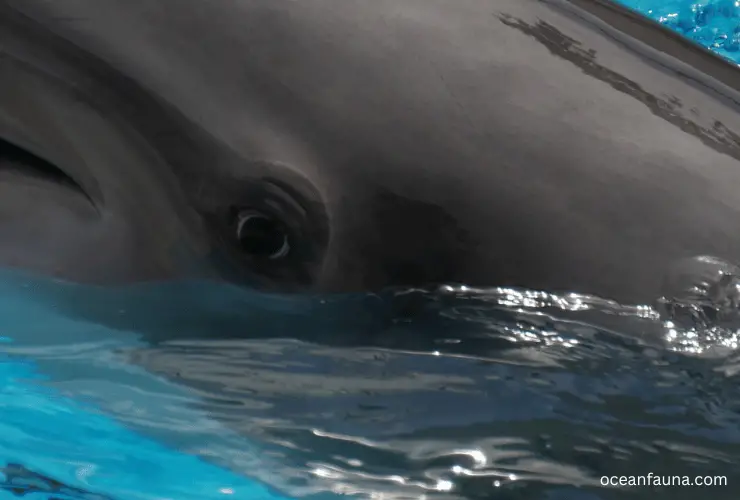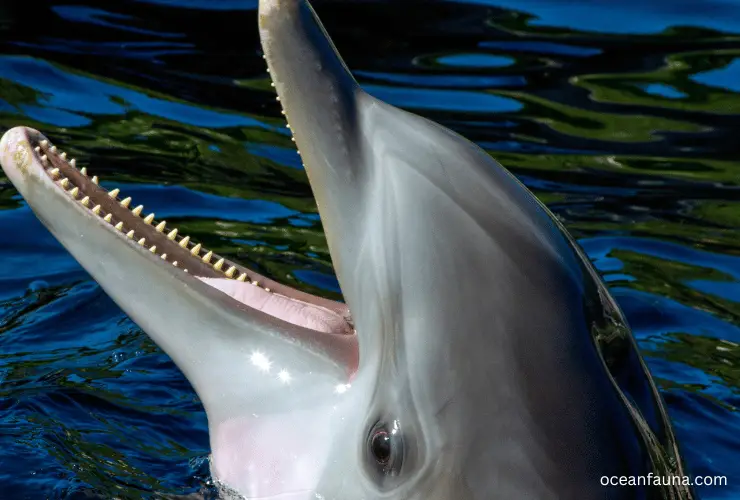Yes, like all other mammals, dolphins have eyelids but lack the long and fluttery eyelashes that human beings have. Furthermore, their eyelids are vastly distinct in form and structure, which I shall explore further in this discussion.
To know the detail of the anatomy, dolphins eye dive into the detail.
Do Dolphins Have Eyelids?
Unlike humans, Dolphins have thick, heavy eyelids that are hard to move. Due to this difference in structure, dolphins tend to blink less than other animals. These heavy eyelids serve an important purpose for dolphins in that they help protect the eyes from exposure to dangerous objects and debris.

Additionally, dolphins produce tears which are spread over the entire eye by blinking. This solution can remain on the eyes for several hours at a time, thus protecting them against potential harm caused by outside elements.
In addition to playing a role in protection, a dolphin’s lid also serves as an important component when it comes to communication. Dolphins use subtle movements in their eyelids and surrounding facial muscles as part of their complex body language system, helping them communicate with one another and share information about their environment or feelings.
Dolphins also have special lids that help them see better. The fat in the lids helps make small pockets around the eye that act like magnifying glasses when the lids are open wide underwater. This helps them see better when they are swimming long distances or looking for food below the water’s surface.
Do Dolphins Have Eyelashes?
No, dolphins do not have eyelashes. Although they have eyelids that can be used to protect their eyes from irritants or other foreign bodies in the water, no aquatic mammal has evolved to have true eyelashes.
Unlike land-dwelling mammals, dolphins and other aquatic creatures rely on other means of eye protection from the environment due to their unique anatomy and lifestyle.
The outer covering of a dolphin’s eye is instead protected by a thick protective layer of connective tissue known as the nictitating membrane. This thin transparent membrane slides across the eye’s surface when needed to protect it from water debris or other irritants.

Additionally, unlike mammals that live exclusively on land, dolphins also have specialized glands near their eyes, which produce oils that help protect them from irritation caused by saltwater.
Unlike land-based animals, whose environment is largely static and unchanging, dolphins are constantly exposed to different waters with varying levels of salinity, temperature, drastic changes in pressure, and more. As such, they need a much sturdier form of protection than simple eyelashes can provide.
That being said, though dolphins lack true eyelashes (which are made up of finer hairs), they do possess thicker eyelids around their eyes which help keep out large particles like sand or debris while swimming.
Dolphins Eye Anatomy
Dolphins are fascinating marine mammals with unique adaptations that enable them to thrive in aquatic environments. Their eyes have evolved over time so that they can see well underwater. This is one of the most important changes that has helped them survive.
Double Slit Pupil and Adaptations for Underwater Vision
A dolphin’s eye has a double-slit pupil, which allows for similar visual acuity in air and water. Their eyes are also able to deal with different levels of light because they have a well-developed tapetum lucidum that reflects light through the retina a second time. This lets them adjust to low levels of light.
Also, their retinas have rod and cone cells, which means they can see in both dim and bright light.
Monocular and Binocular Vision
Dolphins are primarily monocular, meaning they use one eye to process visual stimuli. However, they can also see with both eyes at the same time, which is called binocular vision.
Studies have suggested that dolphins may use their right eye predominantly for approaching and investigation when processing visual information.
Color Vision and Fatty Eyelids
Behavioural studies have suggested that dolphins may have some colour vision, but more research is needed to determine the extent of their colour vision capabilities. Additionally, dolphins do not have eyelashes but have fatty and thicker eyelids that help protect their eyes.
Dolphins Eye Vs Other Mammals: Similarities and Dissimilarities
Mammals’ eyes have changed over time to meet the specific needs of their environments and ways of life. In the case of dolphins, their eyes are adapted to provide excellent underwater vision. While there are some similarities between dolphin eyes and those of other mammals, there are also some key differences.
Similarities: Dolphins eye vs other mammals
Structure of the Eye: Dolphins, like other mammals, have a similar basic structure to their eyes. The eye consists of several key components, including the cornea, iris, pupil, lens, retina, and optic nerve.
Rods and Cones: Dolphins, like most mammals, have both rods and cones in their retinas. Rods are responsible for vision in low-light conditions, while cones are responsible for colour vision and visual acuity.
Binocular Vision: Most mammals, including dolphins, have binocular vision, which allows for depth perception and the ability to judge distances. This is achieved when both eyes work together to create a unified image.
Differences: Dolphins eye vs other mammals
Double Slit Pupil: One of the unique features of dolphin eyes is their double slit pupil, which allows for similar visual acuity in air and water. This adaptation is not found in the eyes of most other mammals.
Tapetum Lucidum: Dolphin eyes also have a well-developed tapetum lucidum, which reflects light through the retina a second time and allows them to adapt to low-light conditions. This adaptation is found in many mammals but is particularly well-developed in dolphins.
Fatty Eyelids: Unlike most other mammals, dolphins do not have eyelashes. Instead, they have fatty and thicker eyelids that help protect their eyes from water pressure and other potential hazards.
Colour Vision: While most mammals have some degree of colour vision, it is believed that dolphins may have limited colour vision. They are thought to lack S-cone cells responsible for colour discrimination in the blue wavelengths.
Can Dolphins Close Their Eyes?
Yes, dolphins can close their eyes. In fact, dolphins only close one eye when they sleep. This process is known as unihemispheric sleep, wherein only one brain hemisphere sleeps at a time. When the right eye closes during unihemispheric sleep, the left half of the brain sleeps, and vice versa.
Why Do Dolphins Keep One Eye Open?
The reason why dolphins keep one eye open while they are sleeping is due to their need for constant vigilance in their aquatic environment. The ability to enter into unihemispheric sleep allows dolphins to rest while still remaining partially alert to potential dangers in their vicinity, such as predators or other threats. Dolphins can stay alert even when they are sleeping because they keep one side of their brains awake and alert.

This way of sleeping gives dolphins an evolutionary advantage by keeping them safe from predators. It also gives them physiological benefits, such as more efficient use of energy and better mental performance because REM sleep cycles don’t get interrupted on the side of the brain that is sleeping.
Furthermore, unihemispheric sleep has been linked to enhanced learning and memory capacity in cetaceans as well as certain species of birds – allowing them to adapt quickly and efficiently to changing environments.
Lastly, research suggests that this type of semi-conscious state may have psychological benefits like increased creativity by freeing the resting hemisphere from normal levels of self-consciousness or inhibition.
What Is Special About the Dolphin’s Eyes?
Dolphins’ eyes are actually developed for underwater seeing. They can change the size of their pupils to the brightness of the environment, and their spherical lenses provide them sharp eyesight both in and out of the water.
The tapetum lucidum, a layer of tissue in dolphins’ eyes, helps them see better in dim light by reflecting light back through the retina.
Also, dolphins have an eyelid called a nictitating membrane that protects their eyes from harm without getting in the way of their vision. With these modifications, dolphins are able to thrive in the water and make their eye special.
What Shape Are Dolphins’ Eyes?
Dolphins’ eyes are oval, which helps them see in bright surface water and dimly lit depths. Their eye’s lens is positioned in such a way that even the smallest ray of light cannot escape the retina, allowing them to see clearly underwater.
Dolphins use their particular eye shape and orientation to navigate their underwater surroundings and locate prey with precision.
Do Dolphins Have Glowing Eyes?
Yes, dolphins’ eyes can look like they glow or shine in the dark. This is because they have a special reflective layer called the tapetum lucidum, just below their retina. This layer bounces light back through the retina, improving vision in low-light circumstances. This effect is comparable to how the eyes of a cat might appear to glow in the dark. However, the level to which their eyes appear to shine varies depending on the lighting circumstances and the angle from which they are viewed.
Conclusion
Hopefully, now you are clear that dolphins have lashless, thick and fatty eyelids that protect their eyes from the dust of water and the harsh environment in which they live. For the thick layer, they can’t blink so often. Also, for the presence of tapetum lucidum, this mammal is well adapted to see in the dark with catty glowing eyes.

